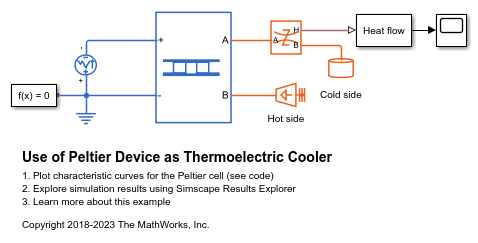Use of Peltier Device as Thermoelectric Cooler
This example shows a Peltier device working in cooling mode with a hot side temperature of 50 degC. In cooling mode, the Coefficient of Performance (COP) of the Peltier cell is equal to the total heat transferred through the Thermoelectric cooler (TEC) divided by the electric input power, COP = Qc/Pin.
The first subplot shows the COP as a function of current for several temperature differences. It can be observed that, for the same current value, the COP value is lower for larger temperature differences. This happens because at higher temperature differences, the natural heat conduction from the hot side to the cold side tends to be greater.
The temperature source connected to the hot side of the Peltier module allows to represent an ideal heat sink. That is, a sink capable of dissipating an infinite amount of heat without increases in temperature at the hot side. This representation gives us a good approximation for the COP and cooling flow curves.
The second graph shows how the heat flow evolves with the input current. As the current increases, the heat extracted from the cold side increases until it reaches a maximum value. After this peak, due to joule heating, increases in current lead to a decrease in the cooling flow.
The last graph shows the operating current that maximizes the COP value for each temperature difference. This optimum operating point provides useful information when choosing the TEC controller output current.
The Peltier block used in this model is defined by:
Seebeck coefficient = 220e-6 V/K;
Internal resistance = 0.02 Ohm;
Thermal conductance = 1.5e-3 W/K.
Model

Simulation Results from Simscape Logging
The plot below shows the results for the Peltier Device's coefficient of performance and heat pumping capacity against input current at various temperature differences.

Results from Real-Time Simulation
This example has been tested on a Speedgoat Performance real-time target machine with an Intel® 3.5 GHz i7 multi-core CPU. This model can run in real time with a step size of 30 microseconds.